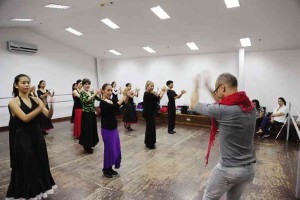
In flamenco parlance, there is an undefinable and debatable term called duende which very delicately and loosely could be synonymous with “soul,” but not quite.
Some say it is a performance quality that has the capacity of drawing both performer and spectator into a kind of transcendental state of appreciating the performance; some say that quality is reserved for the performer alone where he or she performs as though bewitched by the dance, the music, the rhythm; and still some say it is a synchronization of the very intricate flamenco compas amongst the quadro: singer, guitarist, dancer and palmista (the one who claps out the rhythm)—to the point that they are solidly one, not just in rhythm but in performance level.
Manuel Betanzos ascribes to the latter description of this slipperishly defined term, duende, which literally means “an elfin or a dwarf.” To language experts, it is one of the hardest Spanish words to translate into English.
In his recently concluded workshop, Betanzos’ teaching style could very easily be described as an intense exercise whose aim was to draw out that trapped spirit in his students. Whether he knew this or not, the exhaustion and exhilaration at the end of each class was not just in the body, but in the mind and soul as well.
Where other flamenco maestros’ concern would be merely to get the rhythm right, Betanzos’ coaching goes beyond the physical. When he gives instructions, his impassioned speech accompanied by expressive body movements is enough to encourage any cold fish to even try to dare extend himself.
Betanzos emphasizes that it is important for his students to absorb and understand style and, through it, express feelings and moods. Each dance style or palo has a different feel, he explains.
In flamenco, there are 50 different palos of which some are just sung, some played, and a number danced along with the singer, guitarist and the person who claps, and each, according to Betanzos, deserves a different attack.
For the master class, he chose to teach bulerias, considered the emblematic flamenco palo. Like most flamenco palos, it makes use of a 12-beat time signature or compas. In bulerias, the count starts with a strong accent of 12, then proceeds to accent the 3rd, 7th, 8th and 10th beats and incorporates counter-rhythms within that framework.
Fluid passion
Having taught in several countries like Japan, Australia, Italy, and, for the first time, the Philippines, Betanzos says that although it can be difficult sometimes to teach fellow Spaniards, it can be more challenging to teach foreigners.
Filipinos, for example, are more reserved in their movements, and for the participants, it took more prodding from Betanzos before more fluid passion was lured out.
The Japanese, he finds, contrary to what others perceive, are not repressed but rather culturally more precise, disciplined and technical, attributes that we presume contribute to a certain stiffness. And precisely because of these attributes, Betanzos finds they are easy to teach, which to him is gratifying. Japan, he points out, has more flamenco schools than in Spain.
Sadly, the European economic crisis has affected all the arts, flamenco included. Dance companies have had a difficult time maintaining themselves; there is less work; and the flourishing of this art has come close to being paralyzed.
Although flamenco’s origins derive from Andalusian and Romani dance styles propagated by the Gypsies, Spain has recognized the art of flamenco as a big part of its heritage, with Unesco declaring it as one of the Masterpieces of the Oral and Intangible Heritage of Humanity.
It may not be such a farfetched idea to see the continuance of this art on Asian shores, albeit with expected modifications.
At the end of the master class, the participants felt a sense of accomplishment. Perhaps Betanzos had awakened that undefinable duende in each.
The Spanish poet Federico Garcia Lorca stretches the definition when he says that duende “is a power, not a work. It is a struggle, not a thought… [it] climbs up inside you, from the soles of your feet. Meaning this: It is not a question of ability, but of true living style of blood… of spontaneous creation…”
And this, Manuel Betanzos espouses wherever he goes.